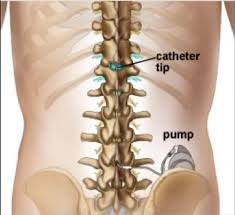Intrathecal Pump Implants
Intrathecal drug delivery, or “pain pump”, is a method of giving medication directly to your spinal cord. The system uses a small pump that is surgically placed under the skin of your abdomen and delivers medication through a catheter to the area around your spinal cord – similar to an epidural that women may have during childbirth.
A pain pump may be a treatment option if all other traditional methods have failed to relieve your long-term symptoms. Because the medication is delivered directly to the spinal cord, your symptoms can be controlled with a much smaller dose than is needed with oral medication. The goal of a drug pump is to better control your symptoms and to reduce oral medications, thus reducing their associated side effects.


Who will benefit from Intrathecal Pump Implants?
Patients with conditions listed below may require the use of intra-spinal morphine pump:
- Cancer pain
- Pain from failed back surgery
- Conditions that leads to high doses of opioid/ morphine use
What are Intrathecal Pump Implants?
The fluid-filled space around your spinal cord is called the intrathecal space. Cerebrospinal fluid (CSF) flows through this area, bathing and protecting your brain and spinal cord. An intrathecal drug pump works much more efficiently than oral medication because it delivers medicine directly into the CSF, bypassing the path that oral medication takes through your body.
The pump is a round metal device about the size of a hockey puck that is surgically implanted beneath the skin of your abdomen. A small plastic tube, called a catheter, is surgically placed in the intrathecal space of the spine and is connected to the pump. A space inside the pump, called the reservoir, holds the medication.
The pump is programmed to slowly release medication over a period of time. It can also be programmed to release different amounts of medication at different times of the day, depending on your changing needs. The pump stores the information about your prescription in its memory, and your doctor can easily review this information with the programmer. When the reservoir is empty, the doctor or nurse refills the pump by inserting a needle through your skin and into the fill port on top of the reservoir.
This therapy is completely reversible, should you ever decide to have the pump removed.



